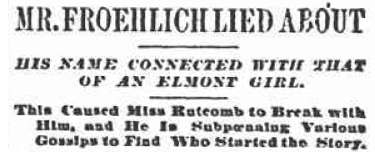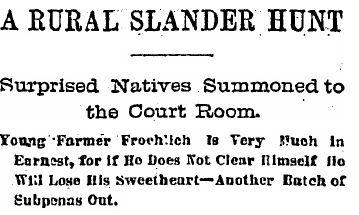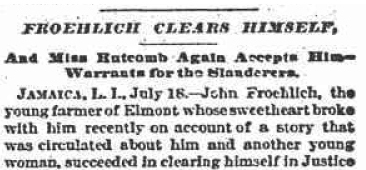Ed Wesnofske
Rural agricultural life poses several challenges for romance and marriage.
The small population of such a community limits the number of persons available as potential mates. In Foster's Meadow, ambition for elevated economic social status beyond that of farmer may have made some women limit their interest in agricultural males of a farming community and search elsewhere thereby decreasing opportunities as mates in the community.
The intense institutions of a small community like Foster's Meadow built familiarity for the young around elementary schooling, church going, small town commerce, common economic interests and community social entertainments like those introduced by the German immigrant families. These created a small corral for mate selection and made for much intermarriage among families of separate origins in one generation, particularly in the case of families with German ancestry.
For agricultural life, large families existed to generate cheap family agricultural labor and the social security system of the time: parents of dependent aging needs being cared for with the places and resources (sometimes inherited) of their young.
Thus, there were often large numbers in Family A living in close proximity to another Family B in which the condtions of nearness and familiarty made mate selection easier if not always successfully blissful.
So it is not uncommon to find pressures to marry within very localized family circles. The most obvious manifestation is the pairing of two siblings of one family marrying two siblings of a second family.
In the case of the writer's four sets of great grandparents (three having lived in Foster's Meadow), there exists in each of the four branches examples of the two siblings of one family marrying two siblings of another family.
In the case of Foster's Meadow families, one of the most prominent Double Play of siblings marrying siblings is that of the sisters Rottkamp marrying the brothers Froehlich.
Bernard and Caroline Rottkamp had a large family in their Foster's Meadow domain. Not unusual for the time, but tragically never-the-less, there were two infant deaths and two adolescent deaths. Despite these deaths, there were ten surviving children who married (and were to procreate 103 births for the next generation!).
Less than half a mile away as the crow flies from the Rottkamps homestead on Foster's Meadow Road (and 3/4 mile following the dirt path off Central Avenue into the Town of Jamaica) was the Frank and Madeline Froehlich family. There, the two oldest sons Frank and George found romance with two daughters of Bernard Rottkamp. Caroline married Frank January 16, 1883. Elizabeth married Frank March 2, 1886. By 1894, the Froehlichs joined the Wulforst, Muller, Haslach, Miller, Schmitt, and Jacob families as spouses of nine of the ten Rottkamp children.
The tenth and youngest child of Bernard and Caroline, daughter Anna Rottkamp (born 1875), was unmarried in 1894.
She caught the eye of John Froehlich (born 1867). He had already been married and become an early widower. His older brothers Frank and George already had Rottkamp wives.
Anna became sweet on John as did John on Anna. And the romance proceeded forward enough that the community was of a mind that the forthcoming marriage would be the social occasion of the year.
On July 4, 1894, farmer John dressed for the occasion of meeting his sweetheart and taking her to a picnic at Foster's Meadow sponsored by the Catholic Benevolent League.
He drove from Foster's Meadow toward Springfield Store along Central Avenue and when he arrived at the Rottkamp place, mother Caroline informed John Froehlich that daughter Anna had already gone to the picnic. Disturbed, John immediately went to the picnic and sought out Anna.
John asked for an explanation on why he was stood up. Anna replied in the midst of a surprised audience with a curt "I will have nothing more to do with you, sir. I have found you have deceived me ".
The community was ablaze in gossip for the following week about the to do between members of two families of status in the agricultural community. Was there another man in Anna's life?
Then after a week another rumor surfaced in the gossip circuit. John Froehlich was involved with another woman. The rumor pegged 17 year old Annie Brown of Hempstead Town as John's paramour. Born in New York of Irish parents no less, not German. The rumor reached John's ear.

As word spread of the possible meaning and identity of the "John Doe" action in the community, a number of the women subpoeaned lost no time in hurrying to cover their tracks by checking with their neighbors as to what they might have said and thus causing even more notice and stir about the affair.
On the day the case was to be heard, witnesses were accompanied to Mineola by Constable Henry Felton. The court hearing was packed by virtue of the story of the subpoenas being passed far and wide.
Justice Searing was observed as very serious and John Froehlich as looking angry during the hearing.
Questioning was done one by one and out of earshot of the other witnesses by John's lawyer and Justice Searing. The information provided by witnesses gave no conclusive answer as to who first whispered the rumor. All witnesses claimed to have heard the story of John's "other woman" from someone else and was not to have been the originator.
Without a clear answer, lawyer Stanford had a dozen more subpoenas issued to other members of Foster's Meadow society and the case was adjourned until July 18th.

After the first hearing, John Froehlich expressed his confidence that the additional finger pointing about the phony story of his love life that came out in the hearing would lead to justice.
On the day of the resumption of the hearing, additonal witnesses were questioned. Miss Annie Brown, who had been linked in the scandalous story to John, testified she was merely an acquaintance and nothing more and that she would sue her slanderers as well.
Mrs. Phillipa Finn, the wife of Arles Finn who farmed between Central Avenue and Dutch Broadway in Foster's Meadow, finally identified to the satisfaction of the Court the two women who started the tale. The two had previously been examined at the first hearing and as a consequence, Justice Searing issued arrest warrants for them.
Miss Annie Rottkamp was satisfied her lover's denial of the rumor was true and that he had been loyal to her and had proven it by his actions. The couple was reunited in love.

But the Triple Play of Rottkamps to Froehlichs was not to take place.
The couple would split again. John Froehlich would marry another lady eighteen months later. Anna Rottkamp would marry Jacob Jacobs in February 1896.
Because Bernard Rottkamp Jr. had married Mary Jacobs, this would make the second Double Play for the Rottkamp family: the Froehlichs and the Jacobs.
Email: edwesnofske@optimum.net